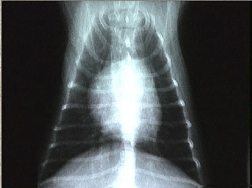Radiology – or X-rays – help our veterinarians evaluate muscular-skeletal, cardiovascular (cardiopulmonary), gastrointestinal, dental, reproductive and urinary systems. These procedures can be of great diagnostic value. Barium and other products can be used to further enhance the intestinal tract and aid in identifying bowel obstructions or foreign bodies. OFA (Orthopedic Foundation for Animals) hip and elbow radiographs are performed routinely at our practice. With the advancement to DIGITAL radiography, images at our clinic are available for evaluation instantaneously!
Diagnostic
When you come to us wondering “what’s wrong with my pet?” We are able to perform many diagnostic procedures in-house to find and then treat the problem. Through the use of a good history, a thorough physical examination, appropriate laboratory workup and diagnostic imaging using x-rays and/or ultrasound, the pieces of the puzzle begin to fall into place. If your pet needs more specialized testing to get the answers, our veterinaries will let you know what is needed, provide an estimate for the costs of those tests and, if necessary, where those specialized tests can be performed.

Ultrasonography (also called ultrasound or sonography) is a noninvasive, pain-free procedure that uses sound waves to examine a pet’s internal organs and other structures inside the body. It can be used to evaluate the animal’s heart, kidneys, liver, gallbladder, and bladder; to detect fluid, cysts, tumors, or abscesses; and to confirm pregnancy or monitor an ongoing pregnancy.
We may use this imaging technique in conjunction with radiography (x-rays) and other diagnostic methods to obtain a proper diagnosis. Interpretation of ultrasound images requires great skill on the part of the clinician.
The ultrasonographer applies gel to the surface of the body and then methodically moves a transducer (a small handheld tool) across the skin to record images of the area of interest. The gel helps the transducer slide more easily and create a more accurate visual image.
The transducer emits ultrasonic sound waves, which are directed into the body toward the structures to be examined. The waves create echoes of varying degrees depending on the density of the tissue and amount of fluid present. Those waves create detailed images of the structures, which are shown on a monitor and recorded for evaluation.
Ultrasound does not involve radiation, is safe, and often doesn’t require pets to be sedated or anesthetized. The hair in the area to be examined may need to be shaved so the ultrasonographer can obtain a good image.
If you have any questions about our ultrasonography service or what to expect during your pet’s procedure, please don’t hesitate to ask.




